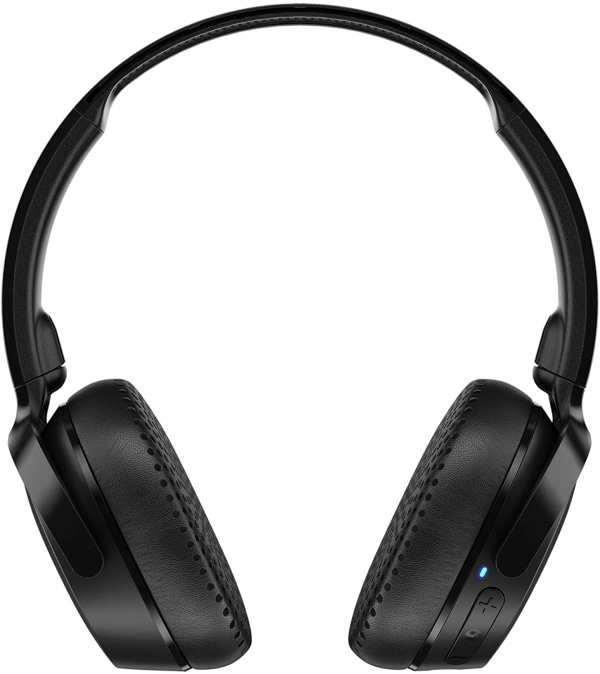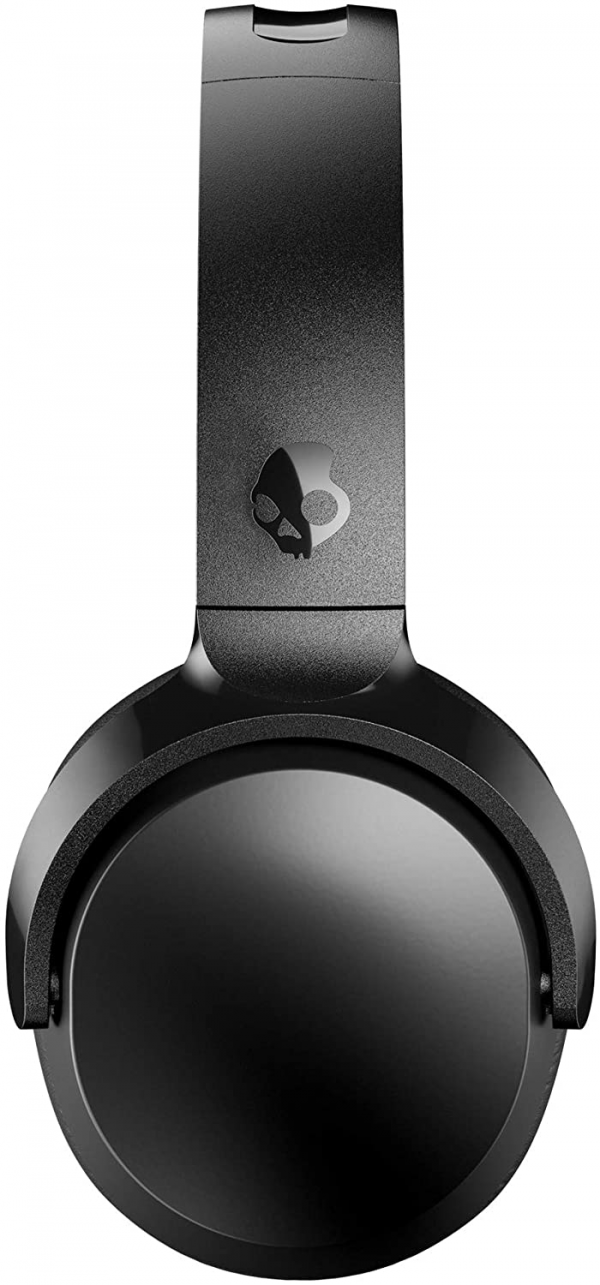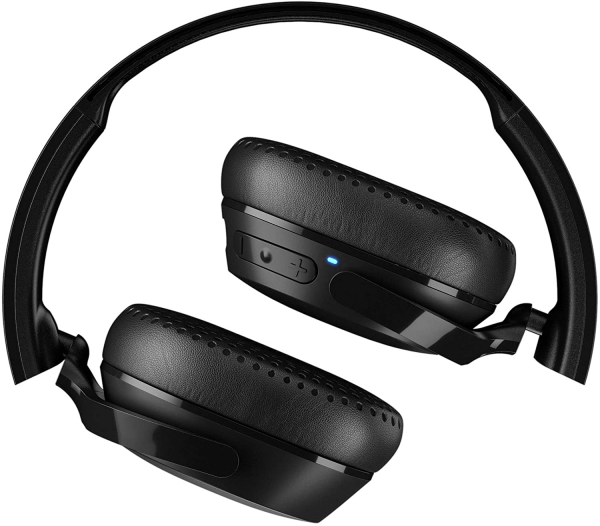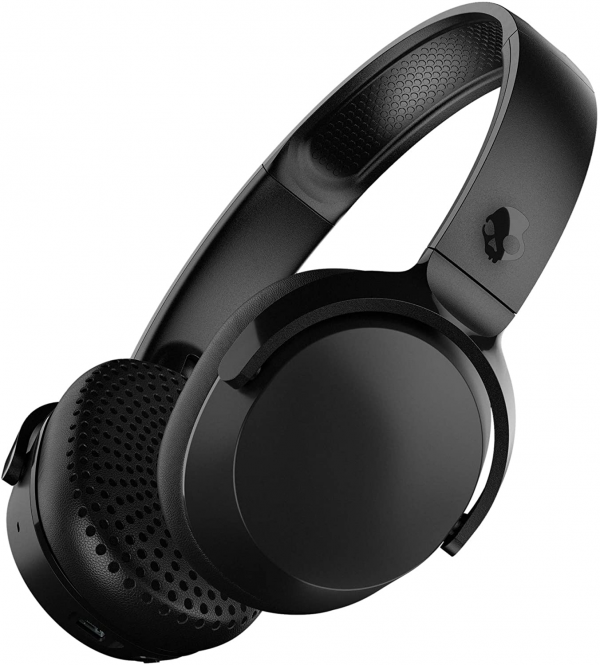Skullcandy
Skullcandy Riff: the Bluetooth headset in its most refined form
Aprox. 39€ - see price -
The Skullcandy Riff arrives with a very simple promise: to offer an efficient and unadorned Bluetooth nomad headset at a very low price (launch price: € 50).
Our review
Ergonomics
The Riff plays the card of the sleek design. These over-ear headphones rest on a chassis made entirely of plastic which gives it an extreme lightness (only 161 g). It therefore does not have the same claims as other models in terms of solidity. We immediately realize this by handling it a bit (shells that sound “hollow”, lack of flexibility ...).
However, the hinges allow the earpieces to lie flat (90 degrees, pads outwards) and above all to fold inwards. The Riff thus easily finds its place in a small bag or in a large pocket. We would have appreciated even a carrying case to protect it, but nothing is provided apart from the USB cable for charging.
If the headband does not benefit from any cushion, the atria host on their side a very thick and soft foam cushion covered with imitation leather. It does not particularly memorize the shape of the pavilions, but the feeling of comfort is not really affected. The extreme lightness of the helmet, the generous pivot on the horizontal and vertical axes of the hinges and the construction of the pads give a very convincing result in use. The Riff can be worn without worry during long sessions of use, even if you wear glasses or are not particularly fond of on-ear designs. The pressure points are distributed homogeneously. There is no exaggerated clamp effect and the helmet remains correctly in place on the head. A very honest comfort experience in short.
We cannot however say that the Riff is a model of insulation, far from it. Even with music in the ears (at a reasonable volume of course), you can still hear the surrounding sounds. Certain sounds (car / motorcycle engine noises, noisy public transport) will mask what you are listening to from time to time: practical for staying aware of your surroundings, much less for putting yourself in a sound bubble.
Simplification is also the watchword in use. Indeed, this model communicates exclusively wirelessly via Bluetooth 4.1 (no details from the manufacturer on compatible codecs, but it seems that only SBC is supported) without the possibility of simultaneous connection to a second device (no multipoint). The 3.5mm mini-jack input is therefore completely absent, which is a great shame when you run out of juice or just want to connect your favorite device without Bluetooth. Speaking of autonomy precisely, the Riff goes further than its promise of only 11 hours of use. In practice, we have repeatedly gone beyond 16 hours of use, which remains very low, even for a helmet of this type. Charging takes place via the micro-USB port located on the helmet.
The Riff has a trio of buttons on the back of the right ear cup, which is directly accessible with the thumb. It is not always extremely easy to activate them (the rubbery surface does not really facilitate handling, especially when you have to press the central button several times), but the controls are complete and responsive. It is possible to manage listening volume, music playback, calls, navigate between tracks and invoke the smartphone voice assistant. A few voice and audio indications are there to guide the user. A LED is also present to facilitate handling when the helmet is not worn.
As on almost all mobile wireless headsets, a hands-free microphone kit is present on this headset. It does not work miracles, but it does its job very well in most cases. The voice is warm and intelligible when you are indoors or on a quiet street. Things get complicated in particularly noisy environments (street with a lot of traffic, wind ...) because the microphone does not really filter the surrounding sounds. In this case, the voice is easily masked by certain sources (engine noises from vehicles passing nearby, etc.) and also becomes muted, more difficult to understand. It is therefore better to go directly through your smartphone so that your contact can hear you better.
Communication latency is slightly below 150 ms: an average result for Bluetooth headsets. In practice, this is enough to follow a video on a mobile phone very well with applications that natively apply a certain amount of latency compensation (such as Netflix, Youtube), even during the dialogue phases. It is more difficult outside of these cases, but not insurmountable either.

Audio
The Riff has some small qualities to assert in the field of performance, but certainly not that of offering a faithful rendering. As our measure clearly shows, he has a very pronounced inclination for low extremes and for highs.
The bass, more precisely the extreme bass, is very generously highlighted. The rendering is very flattering, with a seat and a feeling of impact exacerbated. The membranes keep a very good behavior in the reproduction of this zone: the precision is very correct and the readability is always a minimum guaranteed, even on very demanding pieces in this zone (bass drum attacks and very fast and very bass notes close together, for example). However, this signature is still excessive on certain mixes / songs already very generous in bass, as is often the case in Hip-Hop and Electro, and hearing fatigue happens faster than expected. In addition, the bass is not really defined or present: the feeling of proximity, the warm aspect of certain sources, especially on female voices, is in retreat.
Measurement of membrane reactivity: square waves at 50 Hz (left) and 500 Hz (right)
The intelligibility of the voices is fortunately not called into question, just like the sound presence. The Riff does not deliver a cavernous rendering. It remains impactful and sharp. The mediums are correctly defined and detailed. The restitution in the treble would have deserved better homogeneity. Even if our measurement is a little more generous with the peak located around 8 kHz than what we see when listening, we do perceive an abundance of treble in this area. This behavior emphasizes the metallic aspect of certain elements, in particular the cymbals, and sometimes the whistling of the voice (“sss” and “fff” sounds). The width and depth of the stereophonic field are far from impressive, but the job is guaranteed. We identify the different sources correctly on the horizontal or vertical plane, but it will really be necessary to listen - and be in a very calm environment - to perceive the most discreet and distant effects.
The Riff is not the most exemplary Bluetooth headset when it comes to managing distortion. However, the latter remains at very acceptable levels across the entire audible spectrum.

Conclusion
The Riff largely fulfills its mission. It offers a correct use and listening experience for a tight budget, as small as possible. However, you shouldn't expect too much. Unlike many others, it is impossible to use it wired or passive and the duration of use with a full charge is not incredible. If this is a critical point for you, take a look at other references, like the Move Wireless for example.

Reviews


Fantastic wireless headphones at a great price! I highly recommend them.
I am not a fan of wireless anything. I hate bluetooth so I was not happy about having to switch to wireless headphones. These helped to change my mind because of the ease of connecting them.
SET-UP: My biggest gripe with wireless is that it takes more time to connect everything and get it syched and that it's faster to just plug in a wire. Well, these headphones are just as easy as plugging in a wire. Once you connected them once then any other time you use them it's as easy as flipping a switch to turn them on. And the initial setup wasn't actually bad at all. It took maybe 2 minutes tops to go into my bluetooth settings and add the headset.
VOLUME: I was a little concerned that they wouldn't be loud enough because they aren't noise-canceling and they don't completely incase the ear but rather rest on the ear itself. Volume is not an issue. These get loud enough to listen to with them on the table. They may not be noise canceling but if you blast your music you aren't going to hear anything else. Also, listening to a podcast on a crowded train was no issue. I could hear the podcast clearly.
SOUND QUALITY: Next issue with wireless is that sound quality suffers but this was not an issue either. Music sounds amazing. There is no way you could tell these headphones from a wired pair of headphones. The sound quality is incredible.
BATTERY LIFE: I thought it would suck to have to charge my headphones constantly but you actually don't have to charge them often. I have had my headphones about a month and I think I charged them twice. They charge very fast. They actually shipped charged which was nice. I don't know how long the battery life actually is but that is because I've never had them die on me. So you can easily listen to your headphones for an hour or more on your way to work then an hour or more on the way home from work without having to charge in the middle. I don't know if these stats will last as the battery ages or if I'm just getting lucky based on my usage but I hope they stay this good.
PHONE CALLS: So to my surprise this headset allows you to answer phone calls. I didn't think it would since there is no microphone dangling from a cord near my jawline, so I was pleasantly surprised. Not only can you make and receive calls with the headset but they actually sound great. The person I spoke to said my voice was clear and it didn't sound like I was on a speaker phone or anything like that. On my end, I heard the caller clearly. So, great for handsfree calling.
COST: Great value. Most headsets like this cost well over $ 100 and close to $ 200 so at $ 45 these are a steal.
DURABILITY: This is the one area I ding the headphones for. They feel kinda cheap and plastic. I haven't had an issue with them breaking in any way yet but it feels like they could easily get crushed or they could break if handled aggressively. I mean they aren't complete garbage though. You can drop them on the floor from head height (like I did by accident) and they didn't break when hitting the wood floor. They also fold up into themselves nicely so they can easily fit in a briefcase or bag, which is a huge plus. They can handle being tossed around in my bag all day but I do feel like if I had something heavy in the bag or if I dropped the bag hard I could possibly break the headset.
OVERALL: Great pair of wireless headphones that I would highly recommend.
pretty good for the price
for someone that wants a relatively cheap pair of headphones that look cool and sound decent like as a back up pair or a pair to use for interviews and podcasts when u don't wanna risk losing or breaking your good ones these are great for that. I love the color, the sound is good enough for interviews and podcast I wish it got louder and there pretty comfy cause there so light and made completely of plastic so not great build quality. but for the price and depending what you want them for there pretty cool. also a great starter pair to see if you wanna invest in a better quality one.
Read the Details!
These are a FANTASTIC pair of headphones! Although, since they're budget headphones, you can't expect the highest build quality. The plastic does feel cheap, but as long as you don't abuse them, you'll be fine!
So let's talk about the audio quality. The audio quality is great for such a low price point. The bass is perfect, no large lack and no obnoxious amount of bass. I did have to grow used to the treble through, I have sensitive hearing and sometimes too high of a treble will kill my listening experience. But now they're great!
The build quality is alright. But what's to expect out of a pair of $ 50 headphones? The plastic is somewhat flimsy but I assume that helps to absorb shock when dropped from head height.
Comfort! They are SO comfortable! The earmuffs are very soft, and fit perfectly on the surface of my ears. But keep in mind, these are NOT noise cancelling and do NOT surround the entire ear, so you may deal with a little exterior noise when walking around others.
So far the battery life has been great. I charged them up several hours prior to using them, and they've lasted quite a few hours!
Overall, I believe these headphones are more focus towards entry-level users who have never experienced wireless headphones before. But they're great!
They are awesome
The only bad thing I can say about these headphones is that they tend to fall off when I'm dancin tf around !! Mega comfy and fit quite well, I just get too crazy. Quality sound, the volume doesn't go up quite as high as I would like it but they get plenty loud you can ignore everyone around you .... and they fold up and / or out. You will not find a better set of bt headphones for such a low price.
Great headphones but Grind has a better overall design. Definitely worth the price.
Great headphones. Love Skullcandy. Only complaint is that the top part that rests against your head isn't padded like the Grind so when you lay down on your side it's hard and uncomfortable. Absolutely love the ear cushions- very comfortable and no soreness from long wear. Bluetooth is very reliable. Battery life is about one day of constant use- sightly less than Grind. The blue blinking light is annoying especially in the dark as I can see it in the corner of my eye. I'm also not a fan of the button design in this model. It's difficult to differentiate between the volume keys and power button. The design of the buttons and their location on Grind is way better. Sound quality is great. Good bass and clear speech. It's neat that you can fold up the headphones for easy storage.
Totally comfortable and digging the sound!
I feel like I could wear these headphones for hours! Can't speak to the battery life yet but they are verrry comfortable. Decent bass, maybe a little tinny at times. Sound does bleed but that's other people's problem amiright haha. Bought them for the gym, mostly so that no one tries to talk to me. So far I loved wearing them and dancing around. Overall very happy, like the look too!
So comfortable and great sound
I wear these headphones for hours and they don't annoy me. They are light and have great sound. I listen to audiobooks while I work.
Looks good - feels cheap
Sound is decent but a bit on the low side. The battery life is good. Bluetooth connection is fast and far ranging. The major problem is construction, all thin plastic and no cushion on the headband. On calls, it captures surrounding noise which makes it annoying. Good for a backup pair if you keep it safe.